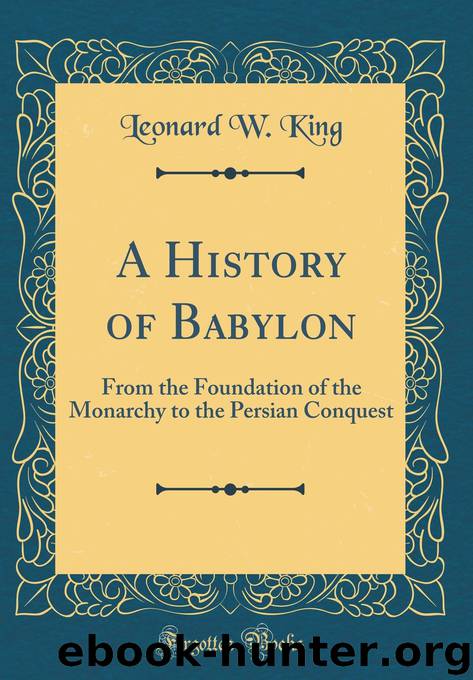A History of Babylon by Leonard W. King

Author:Leonard W. King [Leonard W. King]
Language: eng
Format: epub
Published: 2018-07-21T16:00:00+00:00
CHAPTER V
THE AGE OF HAMMURABI AND ITS INFLUENCE ON LATER PERIODS
Of no other period in the history of Babylon have we so intimate a knowledge as that of the West-Semitic kings under whom the city first attained the rank of capital. It was a time of strenuous growth, in the course of which the long struggle with regard to language and racial dominance was decided in favour of the Semite. But the victory involved no break of continuity, for all the essential elements of Sumerian culture were preserved, the very length of the struggle having proved the main factor in securing their survival. There had been a gradual assimilation on both sides, though naturally the Sumerian had the more to give, and, in spite of his political disappearance, he continued to exert an indirect influence. This he owed in the main to the energy of the Western Semite, who completed the task of transforming a dying culture, so that in its new embodiment it could be accepted by men of a newer race.
Hammurabi's age was one of transition, and we have fortunately recovered a great body of contemporaneous evidence on which to base an analysis of its social and political structure. On the one hand the great Code of Laws supplies us with the state's administrative ideal and standard of justice. [1] On the other we have the letters of the kings themselves, and the commercial and legal documents of the period, [2] to prove that the Code was no dead letter but was accurately adjusted to the conditions of the time. The possibility has long been recognized of the existence of similar codes of early Sumerian origin, and a copy of one of them, on a tablet of the Hammurabi period, has recently been recovered. [3] But the value of Hammurabi's Code rests not so much in any claim to extensive originality, but rather on its correspondence to contemporary needs. It thus forms a first-rate witness on the subjects with which it deals, and where it gives no information, the letters and contracts of the period often enable us to supply the deficiency.
For the purpose of legislation the Babylonian community was divided into three main classes or grades of society, which corresponded to well-defined strata in the social system. The highest or upper class embraced all the officers or ministers attached to the court, the higher officials and servants of the state, and the owners of considerable landed property. But wealth or position did not constitute the sole qualification distinguishing the members of the upper class from that immediately below them. In fact, while the majority of its members enjoyed these advantages, it was possible for a man to forfeit them through his own fault or misfortune and yet to retain his social standing and privileges. It would seem therefore that the distinction was based on a racial qualification, and that the upper class, or nobles, as we may perhaps term them, [4] were men of the predominant, race, sprung from the West-Semitic or Amorite stock which had given Babylon its first independent dynasty.
Download
This site does not store any files on its server. We only index and link to content provided by other sites. Please contact the content providers to delete copyright contents if any and email us, we'll remove relevant links or contents immediately.
| Africa | Americas |
| Arctic & Antarctica | Asia |
| Australia & Oceania | Europe |
| Middle East | Russia |
| United States | World |
| Ancient Civilizations | Military |
| Historical Study & Educational Resources |
The Daily Stoic by Holiday Ryan & Hanselman Stephen(3110)
The Fate of Rome: Climate, Disease, and the End of an Empire (The Princeton History of the Ancient World) by Kyle Harper(2872)
People of the Earth: An Introduction to World Prehistory by Dr. Brian Fagan & Nadia Durrani(2619)
Ancient Worlds by Michael Scott(2493)
Babylon's Ark by Lawrence Anthony(2430)
Foreign Devils on the Silk Road: The Search for the Lost Treasures of Central Asia by Peter Hopkirk(2388)
The Daily Stoic by Ryan Holiday & Stephen Hanselman(2343)
India's Ancient Past by R.S. Sharma(2295)
MOSES THE EGYPTIAN by Jan Assmann(2275)
The Complete Dead Sea Scrolls in English (7th Edition) (Penguin Classics) by Geza Vermes(2135)
Lost Technologies of Ancient Egypt by Christopher Dunn(2111)
The Earth Chronicles Handbook by Zecharia Sitchin(2101)
24 Hours in Ancient Rome by Philip Matyszak(1973)
Alexander the Great by Philip Freeman(1960)
Aztec by Gary Jennings(1877)
The Nine Waves of Creation by Carl Johan Calleman(1783)
Curse Tablets and Binding Spells from the Ancient World by Gager John G.;(1768)
Before Atlantis by Frank Joseph(1740)
Earthmare: The Lost Book of Wars by Cergat(1715)
